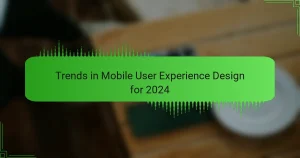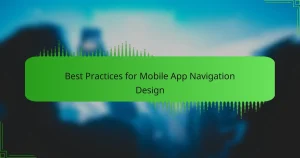Prototyping is a crucial process in mobile software development that significantly enhances user feedback and reduces development costs. By enabling developers to create a visual representation of the application early in the development cycle, prototyping helps identify potential issues and clarify project requirements. This approach fosters collaboration among stakeholders and encourages user involvement, ensuring that the final product aligns with user needs. Research indicates that early user feedback can improve usability by up to 50%, leading to a more efficient development process and a higher quality final product.

What are the Benefits of Prototyping in Mobile Software Development?
Prototyping in mobile software development enhances user feedback and reduces development costs. It allows developers to visualize the application early in the process. This visual representation helps identify potential issues before full-scale development begins. Prototyping fosters collaboration among stakeholders. It encourages user involvement, ensuring the final product meets their needs. Research shows that early user feedback can improve usability by up to 50%. Additionally, prototyping helps in clarifying project requirements, minimizing misunderstandings. Overall, it leads to a more efficient development process and a higher quality final product.
How does prototyping enhance the mobile software development process?
Prototyping enhances the mobile software development process by allowing early visualization of the application. It enables developers to create a functional model before full-scale development. This approach helps identify design flaws and usability issues early on. Feedback from stakeholders can be gathered during the prototyping phase. This iterative process leads to more informed decisions and refinements. According to a study by the University of Southern California, prototyping can reduce development time by up to 30%. By engaging users early, the final product is more likely to meet their needs. Overall, prototyping streamlines communication and improves project outcomes in mobile software development.
What stages of development are most impacted by prototyping?
Prototyping primarily impacts the design, development, and testing stages of mobile software development. During the design stage, prototypes help visualize the user interface and user experience. This allows for early feedback and adjustments before full-scale development begins. In the development stage, prototypes facilitate better communication among team members. They provide a tangible reference that aligns the development process with user requirements. Finally, in the testing stage, prototypes allow for real user testing. This leads to identifying usability issues early, reducing costs associated with late-stage changes.
How does prototyping facilitate better communication among stakeholders?
Prototyping facilitates better communication among stakeholders by providing a tangible representation of ideas. This visual model helps stakeholders understand concepts more clearly. It reduces ambiguity by allowing users to see and interact with the design. Feedback can be gathered early in the development process. This iterative approach ensures that all parties are aligned on expectations. Moreover, prototypes can highlight potential issues before full-scale development begins. Studies show that projects using prototypes experience fewer misunderstandings. Effective communication through prototyping ultimately leads to higher satisfaction among stakeholders.
Why is prototyping essential for user experience in mobile applications?
Prototyping is essential for user experience in mobile applications because it allows designers to test ideas quickly. This iterative process helps identify usability issues early in development. By creating interactive models, developers can gather user feedback efficiently. Research shows that early user involvement improves overall satisfaction. A study by Nielsen Norman Group indicates that prototyping can reduce development costs by up to 50%. Additionally, prototypes enable stakeholders to visualize the final product. This clarity fosters better communication among team members. Ultimately, effective prototyping leads to a more user-centered design.
How does prototyping help in gathering user feedback early?
Prototyping helps in gathering user feedback early by creating tangible representations of concepts. These prototypes allow users to interact with and evaluate design ideas. Early user interaction reveals usability issues and unmet needs. This process enhances user engagement and fosters collaboration. Research indicates that early feedback can reduce development costs by up to 30%. By addressing concerns early, teams can make informed adjustments. This iterative approach leads to a more user-centered final product. Ultimately, prototyping accelerates the development cycle and improves user satisfaction.
What role does prototyping play in usability testing?
Prototyping plays a crucial role in usability testing by allowing designers to create interactive models of their products. These prototypes simulate the user experience and help identify usability issues early in the development process. By testing these models with real users, designers can gather feedback on functionality and design. This feedback informs necessary adjustments before final development. Research shows that early prototyping can reduce development time by up to 30%. Overall, prototyping enhances user satisfaction and product effectiveness through iterative testing and refinement.
What types of prototyping methods are used in mobile software development?
There are several types of prototyping methods used in mobile software development. These include low-fidelity prototypes, high-fidelity prototypes, and interactive prototypes. Low-fidelity prototypes are often paper sketches or wireframes. They allow for quick feedback and iteration at a minimal cost. High-fidelity prototypes resemble the final product closely. They include visual design and functionality, providing a more realistic user experience. Interactive prototypes allow users to engage with the app’s features. They simulate user interactions and workflows effectively. Each method serves a distinct purpose in the development process, facilitating communication and validation of ideas.
What are the differences between low-fidelity and high-fidelity prototypes?
Low-fidelity prototypes are basic representations of a design, often created using paper or simple digital tools. They focus on layout and functionality rather than visual details. High-fidelity prototypes, in contrast, are more advanced and interactive, resembling the final product closely in both functionality and design. They often include detailed graphics, animations, and user interactions.
Low-fidelity prototypes are quicker and cheaper to produce. They allow for rapid iterations and feedback. High-fidelity prototypes require more time and resources to develop. They provide a more accurate user experience and help in usability testing.
Research shows that low-fidelity prototypes can save time in the early stages of design. A study by Nielsen Norman Group emphasizes the importance of quick feedback in the design process. High-fidelity prototypes are beneficial for stakeholder presentations and final testing. They help in identifying potential issues before full development.
How can interactive prototypes improve the design process?
Interactive prototypes enhance the design process by enabling real-time user feedback. They allow designers to visualize concepts early, reducing misunderstandings. Users can interact with prototypes, providing insights into usability. This iterative process helps identify design flaws before development begins. Research shows that early user involvement can decrease project costs by up to 30%. Additionally, interactive prototypes foster collaboration among stakeholders. They serve as a communication tool, aligning expectations between designers and clients. This leads to a more user-centered final product, ultimately improving satisfaction.
How can teams effectively implement prototyping in their workflow?
Teams can effectively implement prototyping in their workflow by integrating iterative design processes. They should start with low-fidelity prototypes to visualize concepts quickly. This allows for early feedback from stakeholders. Incorporating user testing at each stage improves the design based on real user interactions. Teams must maintain clear communication to align goals and expectations. Utilizing collaboration tools can streamline feedback and revisions. Regularly scheduled reviews can ensure the project stays on track. Research shows that iterative prototyping can reduce development time by up to 30%, enhancing overall efficiency.
What tools are available for creating mobile prototypes?
Tools available for creating mobile prototypes include Figma, Adobe XD, Sketch, InVision, and Axure RP. Figma is a web-based design tool known for its collaborative features. Adobe XD offers vector design and prototyping capabilities. Sketch is popular among Mac users for interface design. InVision provides a platform for interactive prototypes and feedback. Axure RP is used for creating detailed wireframes and high-fidelity prototypes. Each tool has unique features tailored to different aspects of mobile prototyping.
How can teams ensure that prototypes align with project goals?
Teams can ensure that prototypes align with project goals by establishing clear objectives from the outset. This involves defining specific project goals and requirements through stakeholder engagement. Regular feedback sessions during the prototyping process help teams to validate alignment. Additionally, using iterative design allows for adjustments based on stakeholder input. Documenting changes and decisions maintains clarity throughout development. Employing user testing can further confirm that prototypes meet user needs and project objectives. Studies show that structured prototyping processes lead to higher project success rates, reinforcing the importance of alignment.
What are common challenges faced when prototyping in mobile software development?
Common challenges faced when prototyping in mobile software development include limited resources, time constraints, and technology limitations. Limited resources can hinder the ability to create comprehensive prototypes. Time constraints often lead to rushed prototyping, which may overlook important features. Technology limitations can restrict the functionality and design of the prototype. Additionally, communication gaps among team members can result in misunderstandings about the prototype’s goals. User feedback may also be difficult to gather effectively in early stages. These challenges can impact the overall quality and effectiveness of the final product.
How can teams overcome resource limitations during prototyping?
Teams can overcome resource limitations during prototyping by prioritizing essential features and utilizing low-fidelity prototypes. Focusing on core functionalities helps to allocate resources more effectively. Low-fidelity prototypes, such as paper sketches or wireframes, require fewer materials and lower costs. This approach allows for rapid iteration and feedback without high investment. Additionally, teams can leverage open-source tools and platforms, which provide free or low-cost resources for development. Collaborating with cross-functional team members also maximizes skills and minimizes resource strain. Lastly, adopting agile methodologies can help teams adjust quickly to changing resource availability, ensuring continuous progress despite limitations.
What strategies can be employed to manage stakeholder expectations?
Effective strategies to manage stakeholder expectations include clear communication, regular updates, and setting realistic goals. Clear communication ensures that all parties understand project scope and objectives. Regular updates keep stakeholders informed about progress and any changes. Setting realistic goals helps avoid disappointment and builds trust. Additionally, involving stakeholders in the decision-making process fosters a sense of ownership. Providing opportunities for feedback allows for adjustments based on stakeholder concerns. Utilizing tools like project management software can enhance transparency. Research shows that projects with proactive stakeholder engagement have higher success rates.
What best practices should teams follow for successful prototyping in mobile software development?
Successful prototyping in mobile software development requires clear communication among team members. Teams should establish a shared understanding of project goals and user needs. Regular feedback loops with stakeholders enhance the design process. Utilizing wireframes and mockups helps visualize the app’s structure early on. Iterative testing allows teams to refine prototypes based on user interactions. Prioritizing user experience ensures that the final product meets audience expectations. Documenting insights and decisions throughout the process aids in maintaining clarity. These practices contribute to a more efficient development cycle and a better end product.
Prototyping is a crucial entity in mobile software development, providing numerous benefits such as enhanced user feedback, reduced development costs, and improved communication among stakeholders. The article outlines how prototyping facilitates early visualization of applications, identifies design flaws, and gathers user input, ultimately leading to a more user-centered final product. It discusses the impact of prototyping on various development stages, the types of prototyping methods available, and best practices for effective implementation. Additionally, it addresses common challenges teams face and strategies to manage stakeholder expectations, emphasizing the importance of iterative design processes for project success.


